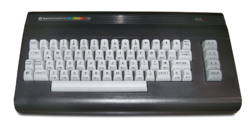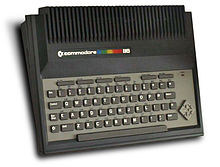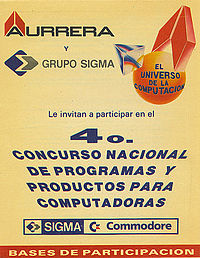- Commodore 16
-
Commodore 16 
Release date 1984 Media ROM Cartridge, Casette tape Operating system Commodore BASIC 3.5 CPU MOS Technology 8501
@ 0.89 MHz or 1.76 MHzMemory 16 KB RAM + 32 KB ROM Display 320x200, 320x160 (with 5 lines of text), 160x200, 160x160 (with 5 lines of text) Graphics TED (320 × 200, 121 colors)[1] Sound TED (2 channels, 4 octaves + white noise) Input Keyboard (66 keys, 4 function keys, 4 cursor keys), Joystick Dimensions 40.7 x 20.4 x 7.7cm The Commodore 16 was a home computer made by Commodore with a 6502-compatible 8501 CPU, released in 1984. It was intended to be an entry-level computer to replace the VIC-20 and it often sold for 99 USD. A cost-reduced version, the Commodore 116, was sold only in Europe.
Contents
Intention
The C16 was intended to compete with other sub-$100 computers from Timex Corporation, Mattel, and Texas Instruments (TI). Timex's and Mattel's computers were less expensive than the VIC-20, and although the VIC-20 offered better expandability,[2][3] a full-travel keyboard, and in some cases more memory, the C16 offered a chance to improve upon those advantages. The TI-99/4A was priced in-between Commodore's VIC-20 and Commodore 64, and was somewhat between them in capability, but TI was lowering its prices. On paper, the C16 was a closer match for the TI-99/4A than the aging VIC-20.
Commodore president Jack Tramiel feared that one or more Japanese companies would introduce a consumer-oriented computer and undercut everyone's prices.[4] Although the Japanese would soon dominate the U.S. video game console market, their feared dominance of the home computer field never materialized. Additionally, Timex, Mattel, and TI departed the computer market before the C16 was released.
Description
Outwardly the C16 resembled the VIC-20 and the C64, but with a Dark Grey case and light gray keys. The keyboard layout differed slightly from the earlier models, adding an escape key and four cursor keys replacing the shifted-key arrangement inherited from the C-64 and VIC. Performance-wise located between the VIC-20 and 64, it had 16 kilobytes of RAM with 12 KB available to its built-in BASIC interpreter, and a new sound and video chipset offering a palette of 128 colors (in reality 121, since the system had a 16 base colors and 8 shades but black always remained black, with all 8 shades), the TED (better than the VIC used in the VIC-20, but lacking the sprite capability of the VIC-II and advanced sound capabilities of the SID, both used in the C64). The ROM resident BASIC 3.5, however, was more powerful than the VIC-20's and C64's BASIC 2.0, in that it had commands for sound and bitmapped graphics (320×200 pixels), as well as simple program tracing/debugging.
From a practical user's point of view, three tangible features the C16 lacked were a modem port and VIC-20/C64-compatible Datassette and game ports. Commodore sold a C16 family-specific cassette player (the Commodore 1531) and joysticks, but third-party converters to allow the use of the abundant, and hence much less expensive, VIC-20/C64-type units soon appeared. The official reason for changing the joystick ports was to reduce RF interference. The C16's serial port (Commodore's proprietary "serial IEEE-488 bus", no relation to RS-232 and the like) was the same as that of the VIC-20 and C64, which meant that printers and disk drives, at least, were interchangeable with the older machines. Commodore modems connected to the User port, which was intended for a variety of technical interfacing uses. Since telecommunications was in general highly technical at this time, Commodore left this feature out of the beginner-oriented C16.
The Commodore 16 was one of three computers in its family. The even less successful Commodore 116 was functionally and technically similar but was shipped in a smaller case with a rubber chiclet keyboard and was only available in Europe. The family's flagship, the Commodore Plus/4, was shipped in a similar case but had a 59-key full-travel keyboard (with a specifically advertised "cursor key diamond" of four keys, contrasted with the VIC-20's and C64's two + shift key scheme inherited from the PET), 64 KB of RAM, a modem port, and built-in entry-level office suite software. A relatively simple internal RAM expansion could make the C16 almost equivalent to the Plus/4, allowing it to run the same software, with the exception of comm programs requiring a modem and the built-in office software of the Plus/4. For games however, this expansion created full compatibility.
Hardware designer Bil Herd notes that the C116 was the original member of this family of computers and was the original vision as imparted by Jack Tramiel to the engineering department. It was designed to sell for $49–$79 dollars. The C16 and the Plus/4 came later and were mostly driven by the company trying to figure out what to do with the new computer family after Tramiel's departure from Commodore.
Market performance
The C16 sold poorly in the United States, where it was quickly discontinued, but enjoyed some popularity in Europe as a cheap games machine and Mexico as an initiation computer.[citation needed]
The C16's failure in the USA was likely caused by the lack of commercial software, reduction in price on higher end systems and the system's waning importance to Commodore as competitors withdrew from the market.[citation needed]
Remaining C16, C116 and Plus/4 inventories were dumped at a reduced price on the European market, chiefly Hungary, in the late 1980s, and this created a fan base that contributed several unofficial ports of popular Commodore 64 programs.[citation needed]
Mexico
In Mexico, the C16 was sold as an initiation computer from early 1985 to 1992. Aurrerá supermarkets distributed them with Grupo Sigma S.A. a local distributor of Commodore USA. The computer was marketed as "Sigma-Commodore 16"[5] (all other Commodore computers sold in Mexico had the same moniker), basically this model is the same American/European C16; as it doesn't have the "Ñ" key needed for write Spanish language, the only difference is just the custom label.
Aurrera Supermarket also sold software, peripherals and books about to how to program Commodore Computers. All these merchandise were displayed in special modules at electronics department called "El Universo de la Computación" (The Universe of the Computer Science). The success of Commodore in Mexico were in granted by the fact that Aurrera Supermarket let any people test the machines in store, so people gather to play games and exchange programs in unofficial computer clubs.[6]
At least four annual software writing contests were held sponsored by Aurrera Supermarket, Grupo Sigma and Commodore between 1985 and 1989. These contest had entries for programming, custom hardware and computer graphics for the C16, C64, C128 and Amiga. Prizes included money, Commodore software and hardware and the right to have the software published by Grupo Sigma for the local market. The contest winners had limited sales restricted only to Mexico, so the resulting original software is almost impossible to find.
Grupo Sigma stopped supporting the brand in mid-1993, in favor of the growing (and more profitable) IBM market.
See also
- C16 games
References
External links
- Commodore16.com – A C16 and Plus/4 website that offers a software database, documentation, busy forum, scanned books & Hardware shop
- Plus/4 World – A comprehensive C16 and Plus/4 Game and demoscene site along with books, manuals, PRG files and TAP images of C16 and Plus/4 files
- Commodore 16 information at Old-Computers.Com
List of Commodore microcomputers 6502-based (8-bit) MOS/CBM KIM-1 · PET/CBM · CBM-II (aka B/P series) · VIC-20/VC-20 · C64 · SX-64 · Educator 64 · C16 & 116 · Plus/4 · C12868000-based (16-bit / 32-bit) Amiga 1000 · Amiga 500 · Amiga 2000 (Amiga 2500) · Amiga 1500 · Amiga CDTV · Amiga CD32 · Amiga 3000 · (Amiga 3000UX · Amiga 3000T) · Amiga 500+ · Amiga 600 · Amiga 1200 · Amiga 4000 · Amiga 4000TPowerPC Based x86-based Commodore C64xCategories:- CBM hardware
- Home computers
- 1984 introductions
Wikimedia Foundation. 2010.



